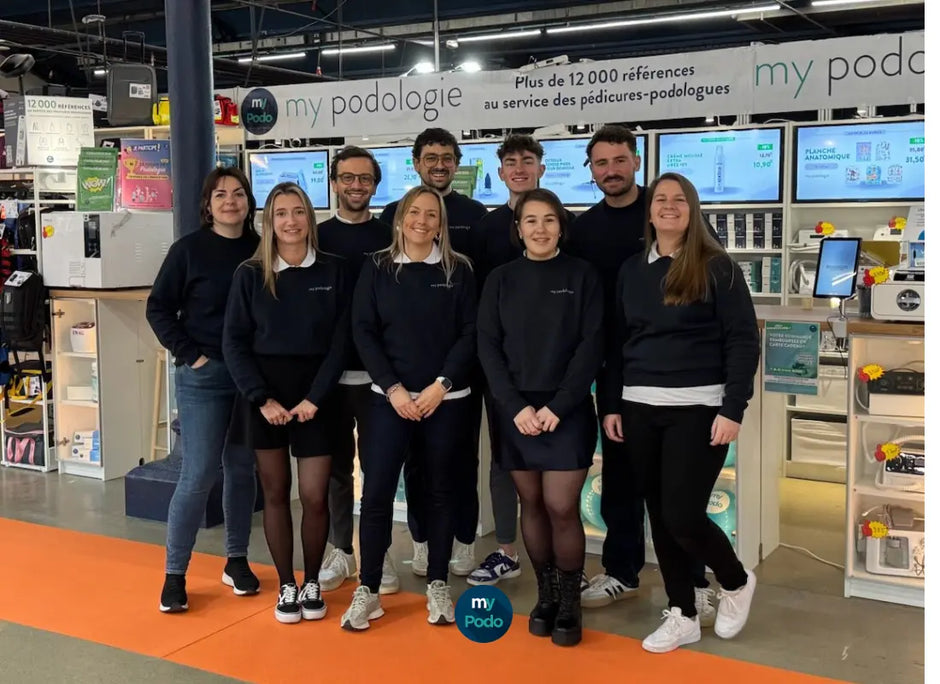Orthonyxia
A small device that seems like nothing, orthonyxia is nevertheless one of our best allies in the treatment of certain pathologies such as ingrown toenails. It has a preventive and curative action on the formation of conflicting nail pathologies. We will see that the installation of these nail orthoses is valued by the scientific community, which raises this practice and the profession of chiropodist-podiatrist to the forefront.
The different types of orthonyxia
There are several types of orthonyxia, which leaves it to each chiropodist to choose their practice according to their professional identity, ideas and creativity. Here are some examples:
- Steel wire staple orthonyxias - Tongue orthonyxias
- Orthonyxies in elastomer chains
- Bacquart tongue orthonyxies - Titanium wire orthonyxies
- VHO-Osthold loop orthonyxias (new method of May 19, 2020)
Main contraindications...
The installation of these nail orthoses are indicated and contraindicated in certain cases. For example, in the case of nail fungus, infections, major ingrown nails, brittle nails or even subungual hematomas, the installation of an orthonyxia may be contraindicated.
Please note that these contraindications are theoretical. Orthonyxia may be performed if the reason for the consultation is a very painful and persistent ingrown toenail. As a podiatrist, we must adapt to the patient in front of us, and judge the usefulness of orthonyxia even in cases where it could be contraindicated.
In this article we will focus on the installation of a titanium wire orthonyxia. We have prepared a video tutorial to explain step by step the installation of a titanium wire orthonyxia:
The necessary materials, step by step
Step #1 - Preparation of the nail and possible removal of a previous orthonyxia using cutting nail clippers.
Step #2 - Removing resin residue and milling the nail plate (etching) using a handpiece and a tungsten carbide nail drill .Step #3 - Suction of the grooves to ensure the total absence of residue. Discover our suction micromotors .
Step #4 - Degrease the nail using nail polish remover, nail cleanser or equivalent such as 70% modified alcohol .
Step 5 - Make notches on each side of the nail with a #1 gouge blade to strengthen the grip of the resin studs.
Step 6 - Apply bonding to the nail ( Bonding No. 1 or Bonding No. 2 ) at the level of the future resin studs using a brush spatula , bonding brushes and a transparent glass cup for bonding .
Step #7 - Photopolymerize the bonding for 10 seconds using an LED photopolymerizing lamp .
Step 8 - Place a first hard resin pad with a titanium wire (Titanium wire in a bag or titanium wire in a reel, both offered by AO). The diameter of the wire depends on the power you want to give to the orthonyxia.
Here is a selection of hard resin:
Step #9 - Photopolymerize the plot for 40 seconds. Repeat for an additional 40 seconds if necessary.
Step #10 - Cut the titanium wire to the appropriate length so that the wire does not enter the opposite groove (leave about 2mm of margin).
Step #11 - Place the second hard resin pad at the end of the previously cut wire.
Step #12 - Hold the wire outside the 2nd plot with an orthonyxis instrument such as a double-ended curette .
Step #13 - Photopolymerization of the 2nd plot for 40 seconds.
Step #14 - Fill the hole left by the instrument inside the 2nd plot with flow resin (liquid).
Here is a flow resin:
Step #15 - Light cure for 40 seconds.
Step #16 - Check and remove any resin residue in the grooves to avoid potential injury from the studs. Check that the titanium wire does not protrude from the 2 studs.
Find all the products and materials needed to create orthonyxies on our website:
The scientific point
Today, the role of the chiropodist in the management of ingrown toenails is known and recognized by science. Indeed, according to several recent scientific sources, the implementation of orthonyxias is preferred to surgery, because it is less invasive and more conservative.
In the various journals, two groups exist: non-conservative treatment which is surgery and conservative treatment which is orthonyxia.
According to the results, partial matrix excision and orthonyxia are equally effective treatments for ingrown toenails. However, the orthonyxia procedure gave better results with fewer postoperative symptoms, shorter recovery time and higher patient satisfaction.
Latest technical information...
In a scientific review from May 2020, it is said that the rate of correction of the othonyxia would be positively linked to the curvature index of the nail and the diameter of the titanium wire (in millimeters). On the other hand, the rate of correction would not be linked to the duration of wearing the orthonyxia (in weeks). It was mentioned that no clinical factor has been correlated with the appearance of side effects following the installation of the orthonyxia.
In conclusion...
According to the scientific community, titanium wire orthonyxia would be in some cases the most optimal treatment for recurrent ingrown toenails. It allows the patient satisfaction with factual results without pain or side effects. This device has proven itself in the prevention and treatment of ingrown toenails and raises the profession of chiropodist-podiatrist to the forefront, compared to the treatment of ingrown toenails by surgery.









